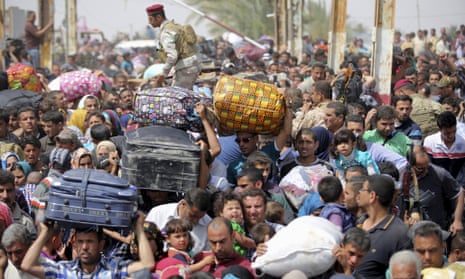The threat of violence from new and ongoing conflicts displaced 11 million people inside their own countries in 2014, bringing the total number of internally displaced people (IDPs) worldwide to 38 million, a report has said.
Conflicts in Iraq, South Sudan and Syria forced more than 4.5 million people from their homes last year, fuelling an estimated 15% surge in the total number of IDPs, according to the annual report by the Norwegian Refugee Council (NRC) and the Internal Displacement Monitoring Centre (IDMC), published on Wednesday.
Last year’s figures show the worst internal displacement “in a generation” signalling that the international community has “completely failed” to protect civilians living in conflict zones, said the NRC’s secretary general, Jan Egeland. Roughly 30,000 people were forced from their homes every day in 2014, according to the study.
Instability in countries like Syria, where a civil war has been raging for more than four years, often forces IDPs to move around their country more than once to avoid violence. In Syria, at least 7.6 million people have been internally displaced, the highest number in the world, and representing 35% of Syria’s population, the report said.
Ukraine’s conflict forced at least 646,500 people from their homes in 2014, marking the first time Europe has experienced mass displacement in more than a decade, according to the report.
The annual report assesses 60 countries and territories that are involved in international or internal armed conflict, or are experiencing religious, ethnic and political violence, in an effort to identify where the highest numbers of people have been internally displaced.
This article includes content hosted on d26adhsj11a4c2.cloudfront.net. We ask for your permission before anything is loaded, as the provider may be using cookies and other technologies. To view this content, click 'Allow and continue'.
In 90% of the countries monitored in the report, there were people who had been displaced for 10 years or longer.
“The longer a conflict lasts, the more insecure [IDPs] feel and when hopelessness sets in, many will cross borders and become refugees,” said Volker Türk, assistant high commissioner for protection at the UN’s High Commissioner for Refugees (UNHCR).
Until lasting peace is established in countries that are engulfed in conflict, mass migration will continue to take place, forcing migrants to take dangerous risks in the hope of finding a safe haven, said Türk. “As we have seen in the recent past, for example in the Mediterranean, despair drives people to take their chances and even risk dangerous boat journeys.”
But serious limitations in data collection mean that the report serves as a barometer and not a comprehensive overview. “Rather than painting a complete picture of displacement in a country, [the estimates] give a general indication of the scale of a number of situations at a given point in time,” the report said.
The NRC said that changes in their data collection methods led to “dramatic adjustments” in this year’s data on internal displacement. Data for the report is provided by governments, NGOs and the UN, it said.
The NRC also cautioned that data collection can vary from country to country, which can affect their estimates. It said: “Due to differences in reporting by our sources, in some cases our new displacement figures reflect the total number of people displaced during the year, whereas in others they reflect only the number of people that remained in displacement at the year’s end.”
It added: “With very few exceptions, comprehensive data does not exist. It may be available for some but not all areas of a country, or it may be collected for some but not all of the factors that determine an overall caseload. Such factors include the number of IDPs who have returned, integrated locally or settled elsewhere, and the number of those born or who have died in displacement.”

Comments (…)
Sign in or create your Guardian account to join the discussion